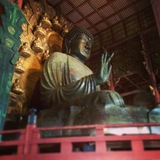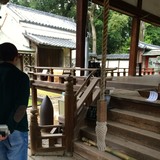 Sonic Tourism at Himuro Shrine
Sonic Tourism at Himuro ShrineStevens and Hosokawa visited the Himuro Shrine in Nara, an ancient city about an hour outside Kyoto. This shrine was established in 710. At this shrine, there was a small playback device at the place of offering. Supplicants put coins in the box at the shrine entrance to make wishes for good health, fortune or other prayers. Next to the donation box was a small recording playback device, donated by an audio speaker company (credited with a small sign). If the supplicant put a few more coins in the device, they could hear gagaku (ancient court music) playing through these speakers. The ancient sounds were thought to enhance the experience of praying at this historic shrine. You can hear Prof. Hosokawa drop in the coins at the start of the recording, and then while waiting, muse out loud 'Nothing's coming out!' As soon as he utters this sentence, however, the recording begins. The supplicant is taken back to Nara's ancient period with this sound. Through the playback you can hear other tourists come and go, and put money in the donation box as the music plays. Hosokawa and Stevens found this shrine's feature unusual and interesting, dubbing it 'sonic tourism'. Sonic tourism enhances the physical experience of being present in a historic setting. (2015/04/06)
 Explore the map
Explore the map
 Multicultural Todaiji
Multicultural Todaiji
 Sonic Tourism at Himuro Shrine
Sonic Tourism at Himuro Shrine